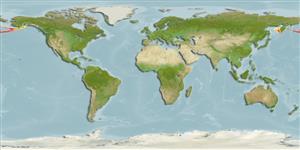Environment: milieu / climate zone / depth range / distribution range
पारिस्थितिकी
समुद्री ड़िमरसल; गहराई सीमा 61 - 530 m (Ref. 56594), usually 100 - 250 m (Ref. 56594). Polar; 0°C - 4°C (Ref. 56594); 66°N - 51°N
North Pacific: northern Kuril Islands (Ref. 56594), Bering Sea and Aleutian Islands, Alaska.
Length at first maturity / आकार / वज़न / Age
Maturity: Lm 17.5, range 17 - 18 cm
Max length : 26.0 cm TL पुल्लिंग / अलिंग; (Ref. 56594); common length : 17.6 cm TL पुल्लिंग / अलिंग; (Ref. 56594); अधिकतम प्रकाशित वज़न: 330.00 g (Ref. 56594); अधिकतम सूचित उम्र: 9 वर्षो (Ref. 56594)
Eschmeyer, W.N., E.S. Herald and H. Hammann, 1983. A field guide to Pacific coast fishes of North America. Boston (MA, USA): Houghton Mifflin Company. xii+336 p. (Ref. 2850)
IUCN Red List Status (Ref. 130435)
Threat to humans
Harmless
Human uses
साधन
Special reports
Download XML
इंटरनेट स्रोत
Estimates based on models
Preferred temperature (Ref.
123201): 1 - 4.5, mean 3.8 °C (based on 49 cells).
Phylogenetic diversity index (Ref.
82804): PD
50 = 0.5156 [Uniqueness, from 0.5 = low to 2.0 = high].
Bayesian length-weight: a=0.00794 (0.00389 - 0.01621), b=3.12 (2.95 - 3.29), in cm total length, based on LWR estimates for this (Sub)family-body shape (Ref.
93245).
Trophic level (Ref.
69278): 3.5 ±0.5 se; based on size and trophs of closest relatives
Generation time: 9.2 ( na - na) years. Estimated as median ln(3)/K based on 1
growth studies.
लौटाव (Ref.
120179): निम्न, न्यूनतम जनसंख्या दुगनी होने का समय 4.5 - 14 वर्ष। (Preliminary K or Fecundity.).
Fishing Vulnerability (Ref.
59153): High vulnerability (56 of 100).
